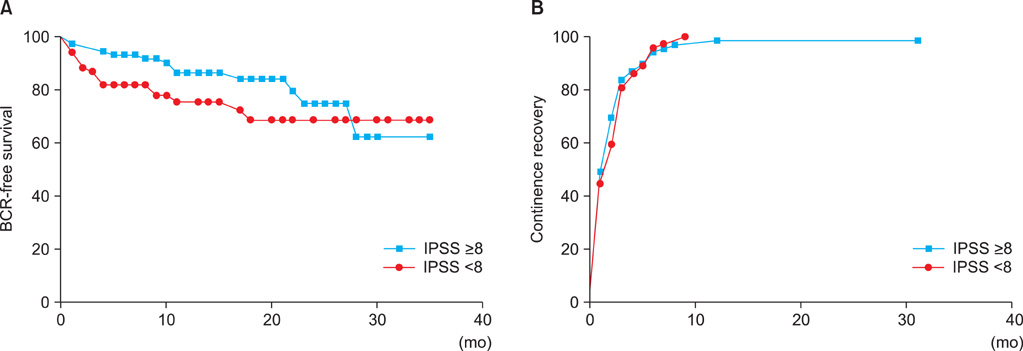Korean J Urol.
2011 Dec;52(12):819-823.
Are Men Who Undergo Radical Prostatectomy with Lower Urinary Tract Symptoms at an Increased Risk for Aggressive Prostate Cancer?
- Affiliations
-
- 1Department of Urology, Gangnam Severance Hospital, Urological Science Institute, Yonsei University College of Medicine, Seoul, Korea. leeseh@yuhs.ac
Abstract
- PURPOSE
We aimed to determine whether prediagnostic lower urinary tract symptoms (LUTS) are associated with the aggressiveness of nonmetastatic prostate cancer (PCa) and compared the clinicopathologic features of PCa patients with and without preexisting LUTS.
MATERIALS AND METHODS
We retrospectively reviewed the medical records of 295 prostate cancer patients who underwent a radical prostatectomy (RP) by a single surgeon from 2006 to 2010. A total of 205 patients were assigned to two groups according to whether they showed preoperative LUTS (International Prostate Symptom Score [IPSS]> or =8). Clinical, operative, pathologic, and postoperative functional data were collected.
RESULTS
The mean age at RP was 62.7 years in the no LUTS group (group A, n=108) and 64.7 in the LUTS group (group B, n=97). The baseline mean IPSS score was 6.1 in group A and 14.6 in group B (p=0.029). The incidence of pathologic T3a stage or above was significantly higher in group B than in group A (p=0.036). The mean postoperative follow-up period was 16.8 months (range, 4 to 38 months). The mean time to biochemical recurrence was 16.9 and 18.2 months in groups A and B, respectively (p=0.148). The median time to recovery of urinary incontinence was 3.6 and 3.3 months in groups A and B, respectively.
CONCLUSIONS
PCa patients without baseline LUTS had a favorable result of pathologic T stage even though there were no significant differences in biochemical recurrence or recovery of postoperative incontinence compared with patients with baseline LUTS.
MeSH Terms
Figure
Reference
-
1. Collin SM, Metcalfe C, Donovan J, Lane JA, Davis M, Neal D, et al. Associations of lower urinary tract symptoms with prostate-specific antigen levels, and screen-detected localized and advanced prostate cancer: a case-control study nested within the UK population-based ProtecT (Prostate testing for cancer and Treatment) study. BJU Int. 2008. 102:1400–1406.2. Porter CR, Kim J. Low AUA symptom score independently predicts positive prostate needle biopsy: results from a racially diverse series of 411 patients. Urology. 2004. 63:90–94.3. Brown CT, O'Flynn E, Van Der Meulen J, Newman S, Mundy AR, Emberton M. The fear of prostate cancer in men with lower urinary tract symptoms: should symptomatic men be screened? BJU Int. 2003. 91:30–32.4. Steginga SK, Occhipinti S, McCaffrey J, Dunn J. Men's attitudes toward prostate cancer and seeking prostate-specific antigen testing. J Cancer Educ. 2001. 16:42–45.5. Tubaro A, De Nunzio C, Mariani S, Trucchi A, Miano R, Vicentini C, et al. Reduction of prostate specific antigen after tamsulosin treatment in patients with elevated prostate specific antigen and lower urinary tract symptoms associated with low incidence of prostate cancer at biopsy. Urology. 2010. 76:436–441.6. Bastian PJ, Mangold LA, Epstein JI, Partin AW. Characteristics of insignificant clinical T1c prostate tumors. A contemporary analysis. Cancer. 2004. 101:2001–2005.7. Consensus statement: guidelines for PSA following radiation therapy. American Society for Therapeutic Radiology and Oncology Consensus Panel. Int J Radiat Oncol Biol Phys. 1997. 37:1035–1041.8. Cookson MS, Aus G, Burnett AL, Camby Hagino ED, D'Amico AV, Dmochowski RR, et al. Variation in the definition of biochemical recurrence in patients treated for localized prostate cancer: the American Urological Association Prostate Guidelines for Localized Prostate Cancer Update Panel report and recommendations for a standard in the reporting of surgical outcomes. J Urol. 2007. 177:540–545.9. Gore JL, Shariat SF, Miles BJ, Kadmon D, Jiang N, Wheeler TM, et al. Optimal combinations of systematic sextant and laterally directed biopsies for the detection of prostate cancer. J Urol. 2001. 165:1554–1559.10. Catalona WJ, Richie JP, Ahmann FR, Hudson MA, Scardino PT, Flanigan RC, et al. Comparison of digital rectal examination and serum prostate specific antigen in the early detection of prostate cancer: results of a multicenter clinical trial of 6,630 men. J Urol. 1994. 151:1283–1290.11. Matsubara A, Yasumoto H, Teishima J, Seki M, Mita K, Hasegawa Y, et al. Lower urinary tract symptoms and risk of prostate cancer in Japanese men. Int J Urol. 2006. 13:1098–1102.12. Farmer A. 10-minute consultation: Prostatic symptoms. BMJ. 2001. 322:1468.13. Jenkins L, Rose P, Wilson T. Prostatic symptoms. Isn't use of prostate specific antigen tests just screening by the back door. BMJ. 2001. 323:750–751.14. Sim HG, Cheng CW. Changing demography of prostate cancer in Asia. Eur J Cancer. 2005. 41:834–845.15. Park SK, Sakoda LC, Kang D, Chokkalingam AP, Lee E, Shin HR, et al. Rising prostate cancer rates in South Korea. Prostate. 2006. 66:1285–1291.16. Sirovich BE, Schwartz LM, Woloshin S. Screening men for prostate and colorectal cancer in the United States: does practice reflect the evidence? JAMA. 2003. 289:1414–1420.17. Borre M. Screening by lower urinary tract symptoms vs asymptomatic prostate-specific antigen levels leading to radical prostatectomy in Danish men: tumour characteristics and treatment outcome. BJU Int. 2009. 104:205–208.18. Kim JM, Song PH, Kim HT, Moon KH. Effect of obesity on prostate specific antigen, prostate volume, and international prostate symptom score in patients with benign prostatic hyperplasia. Korean J Urol. 2011. 52:401–405.
- Full Text Links
- Actions
-
Cited
- CITED
-
- Close
- Share
- Similar articles
-
- Rationale of Surgery in Locally Advanced and Oligometastatic Prostate Cancer
- Impact of Laparoscopic Radical Prostatectomy on Urinary Incontinence and Lower Urinary Tract Symptoms
- Lower Urinary Tract Symptoms after RadicalRetropubic Prostatectomy: Preliminary Study
- Radical Prostatectomy
- Changes in Nocturia and Lower Urinary Tract Symptoms after Radical Prostatectomy


